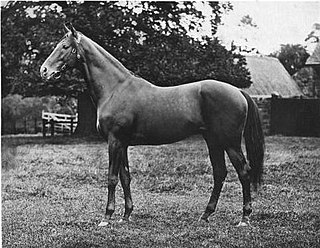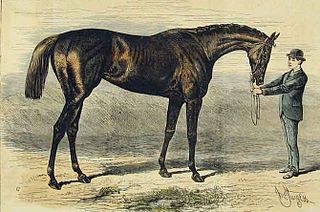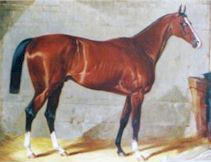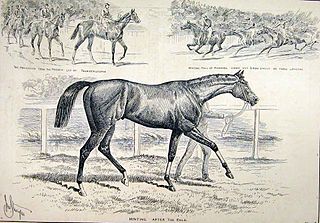
Isinglass (1890–1911) was a British Thoroughbred racehorse and sire. In a career which lasted from 1892 until 1895 he ran twelve times and won eleven races. He was the best British two-year-old of 1892 and went on to become sixth winner of the English Triple Crown by winning the 2000 Guineas at Newmarket, The Derby and the St. Leger Stakes at Doncaster in the following year. He was undefeated in his last two seasons, setting a world record for prize money and gaining recognition from contemporary experts as one of the best horses seen in England up to that time.

Bend Or (1877–1903) was a British Thoroughbred racehorse who won the 1880 Epsom Derby. His regular jockey Fred Archer, winner of thirteen consecutive British jockey titles, said Bend Or was probably the greatest horse he had ever ridden.

Volodyovski (1898–1917) was a British Thoroughbred racehorse and sire. In a career which lasted from 1900 to 1902, he ran twenty-six times and won seven races. After being one of the leading two-year-olds of 1900, he went on to win The Derby in 1901. His subsequent form was disappointing and he was retired to stud after failing to win in eleven starts as a four-year-old. He made no impact as a stallion.

Diamond Jubilee was a British-bred and British-trained Thoroughbred race horse and sire. In a career which lasted from June 1899 until October 1901 he ran sixteen times and won six races.

Persimmon (1893–1908) was a British Thoroughbred race horse and sire. In a racing career that lasted from June 1895 to July 1897 he ran nine times and won seven races. His victories included the 1896 Epsom Derby, one of the first horse races ever filmed, by Robert W. Paul. His other important victories included the St Leger Stakes, the Ascot Gold Cup and the Eclipse Stakes. He was also notable for his rivalry with another English colt St Frusquin, who inflicted his only two defeats.

Jeddah (1895–1909) was a British Thoroughbred racehorse and sire. In a career that lasted from 1897 to 1899 he ran nine times and won three races. In the summer of 1898 he became the first horse to win The Derby at odds of 100/1, and followed up by winning the Prince of Wales's Stakes at Royal Ascot. He was retired to stud after a single, unsuccessful race in 1899, but had serious fertility problems and made no impact as a stallion.

Ladas (1891–1914) was a British Thoroughbred racehorse and sire. His career attracted an unusual amount of attention as his owner, Lord Rosebery, became Prime Minister of the United Kingdom at the height of his success.

Sir Hugo (1889–1910) was a British Thoroughbred racehorse and sire. In a career that lasted from 1891 to 1894 he ran eight times and won three races. As a three-year-old in 1892 he won The Derby at odds of 40/1. He was a consistent performer in top class races, but certainly inferior to his contemporaries Orme and La Fleche.

Melton (1882–1910) was a British Thoroughbred racehorse and sire. In a career that lasted from 1884 to 1886 he ran eighteen times and won eleven races. In 1885 he won the second two legs of the English Triple Crown, the Derby at Epsom and the St Leger at Doncaster. At the end of the 1886 season he was retired to stud where he had considerable success in both Italy and Great Britain.

Shotover (1879–1898) was a British Thoroughbred racehorse and broodmare. In a career that lasted from 1882 to 1884, she ran 15 times and won five races. As a three-year-old, racing against colts, she became the first filly to win the first two legs of the English Triple Crown: the 2000 Guineas at Newmarket and the Derby at Epsom. She went on to win twice at Royal Ascot, but failed in her bid for the Triple Crown when she finished third in the St Leger at Doncaster. She was retired in 1884 and became a successful and influential broodmare. Shotover died in 1898.

St. Blaise (1880–1909) was a British Thoroughbred racehorse and sire. In a career that lasted from 1882 to 1884 he ran twelve time and won seven races, although three of these wins were walk-overs. His most important success came in 1883 when he won The Derby. At the end of the season he was sold and exported to the United States to stand as a stallion where he had some success. St. Blaise was killed in a fire in 1909.

St. Gatien was a British Thoroughbred racehorse and sire. In 1884 he was involved in the second and final dead heat in the history of The Derby, part of an unbeaten sequence of twelve races. St. Gatien went on to become a dominant performer in long-distance races, winning the Gold Cup and the Alexandra Plate at Royal Ascot, the Cesarewitch Handicap carrying a record weight, and three successive running of the Jockey Club Cup.

Isonomy was a British Thoroughbred racehorse and sire. In a career that lasted from 1877 to 1880 he ran fourteen times and won ten races. As a three-year-old he deliberately bypassed the Classics in order that his owner could land a massive betting coup in the Cambridgeshire Handicap at Newmarket. In the following two seasons he was the dominant stayer in Britain, producing a series of performances which led many contemporary observers to regard him as one of the greatest racehorses of the 19th century. He was then retired to stud, where he became a successful stallion.

La Fleche (1889–1916) was a British Thoroughbred racehorse and broodmare. After being sold for a world record price as a yearling in 1890, she was undefeated as a two-year-old in 1891, winning races against her own sex and defeating some of the year's leading colts. She went on to become the dominant British three-year-old of 1892, claiming the Fillies’ Triple Crown by winning the 1000 Guineas at Newmarket, the Oaks at Epsom and the St Leger at Doncaster. Her only defeat of the year came when she finished second when starting favourite for The Derby.

Minting (1883–1909) was a British Thoroughbred racehorse and sire. In a career that lasted from 1885 to 1888 he ran twelve times and won nine races. He was the leading British two-year-old of 1885 and went on to win the Grand Prix de Paris in June 1886. His career was often overshadowed by that of his contemporary Ormonde who defeated him on both of the occasions they met on the racecourse.

Foxhall (1879–1904) was an American-bred Thoroughbred racehorse and sire. He was trained in Britain during a racing career that lasted from 1880 until June 1882 during which he ran eleven times and won seven races. As a three-year-old in 1881 he proved himself to be the outstanding colt of the season in Europe, winning the Grand Prix de Paris and becoming the second of only three horses to complete the Autumn Double of the Cesarewitch and the Cambridgeshire.

Silvio (1874–1890) was a British Thoroughbred racehorse and sire. In a career that lasted from 1874 to 1877 he ran eight times and won three races. In 1877 he won The Derby and the St Leger. At the end of the 1877 season he was retired to stud where he had success both in England and France.

Tristan (1878–1897) was a British Thoroughbred racehorse and sire. In a career that lasted from the April 1880 to October 1884, he ran 51 times and won 27 races. A useful performer at two and three years old, he matured into an outstanding horse in his last three seasons, winning important races at distances ranging from six furlongs to two and a half miles and defeating three winners of The Derby. Unusually for a 19th-century racehorse, he was regularly campaigned internationally, winning three consecutive runnings of the Grand Prix de Deauville. Tristan's success was achieved despite a dangerous and unpredictable temperament: at the height of his success, he was described as "a very vile-tempered animal".

Busybody (1881–1899), was a British Thoroughbred racehorse and broodmare who won two British Classic Races in 1884. In a racing career which lasted from September 1883 until May 1884 she ran six times and won five races. As a two-year-old in 1883 she won her first three races including the Middle Park Plate and the Great Challenge Stakes before sustaining her only defeat when conceding weight to the winner Queen Adelaide in the Dewhurst Stakes. As a three-year-old she won the 1000 Guineas over one mile at Newmarket and The Oaks over one and a half miles at Epsom Downs Racecourse a month later. She was then retired to stud where she became a successful broodmare.
Petronel was a British Thoroughbred racehorse and sire. After showing promise when winning the Troy Stakes as a juvenile in 1879, he recorded a major upset when defeating his more fancied opponents to take the 2000 Guineas in the following spring. He had never been entered in the other British Classic Races, but won at Royal Ascot and in several other top-class races that year. In 1881 he was one of the best staying horses in England, winning seven races including the Epsom Stakes, Rous Memorial Stakes, Great Yorkshire Handicap and Doncaster Cup as well as Queen's Plates at Stockbridge, Newmarket and Liverpool. He developed breathing problems and was never as good again, although he won Queen's Plates at Stockbridge and Newcastle in 1882. After his retirement from racing he had some success as a breeding stallion.



















